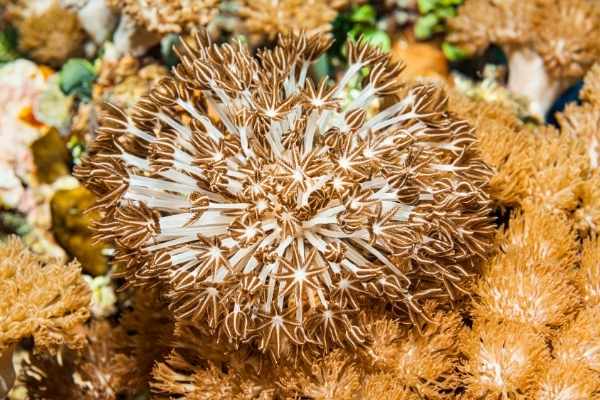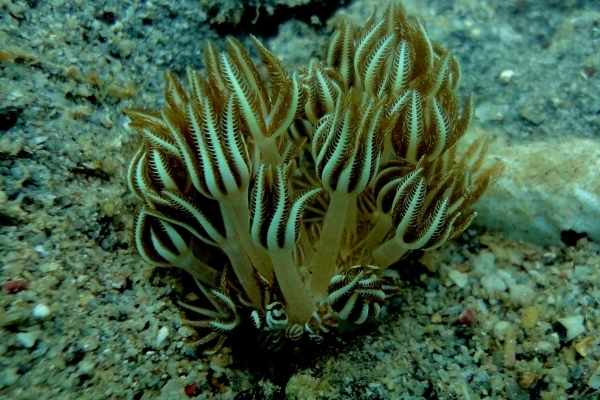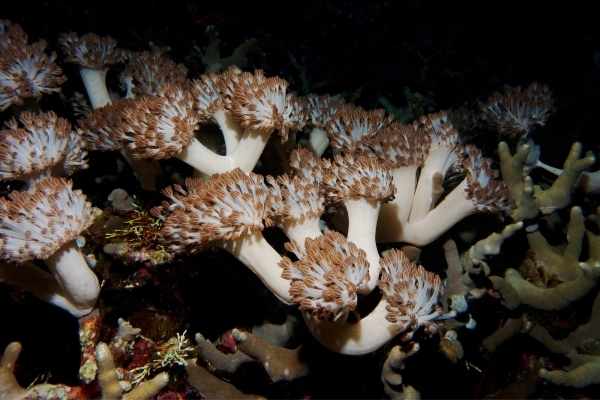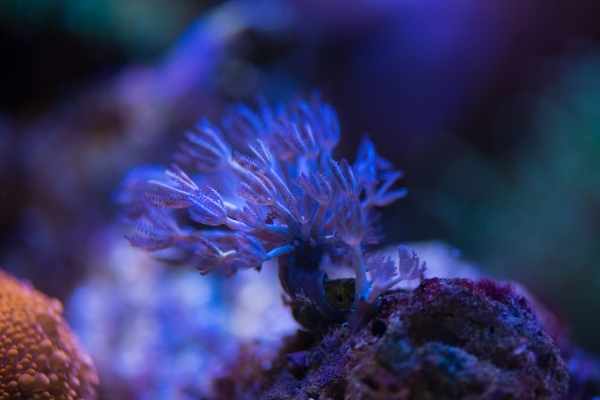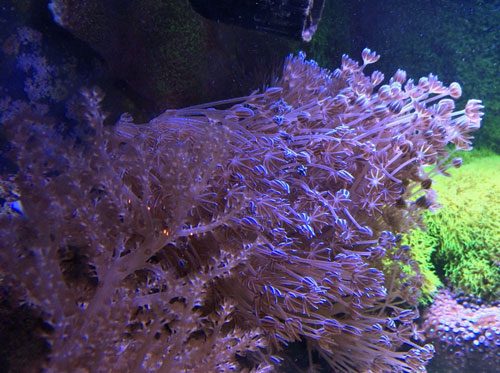[ad_1]
The pulsing xenia coral is a popular, fast-growing, easy to frag soft corals species.
This easy to care for coral gets its name because of the rhythmic pulsing action of the coral polyps that look like a hand opening and closing. This activity, which is relatively uncommon among the sessile invertebrates we keep in the tank, is part of what makes this coral endearing.
Once accustomed to the tank, it can be quite a hardy coral with an amazing growth rate, depending on the light amount and nutrient levels in the tank, earning a space as a weed among some of the more advanced SPS (and perhaps slightly judgmental…?) aquarium owners.
You may find Xenia elongate at your local fish store in either brown, white, pink, or cream color morphs. The pom-pom xenia head sits atop a stem that is generally about 3 inches tall (when fully grown).
It also goes by some other names, like Xenia elongata (the official scientific classification), or Pulse Coral, Pulsing Xenia, Hand Coral, Pom Pom Coral, Red Sea Xenia or Bouquet Encrusting coral in some areas.

The rhythmic pulsing of the pom-pom hands can be hypnotic and will fascinate your guests once they realize it isn’t just caused by the flow in the tank
A warning
A couple of years ago, there was a lot of (fake) news about the pulsing xenia causing palytoxin poisoning. I don’t believe I have seen conclusive proof that the poisoning was caused by the x. elongata, rather than a palythoa, but in the meantime, you may want to pause on adding this to your tank, until the details get sorted out. Here is some of what is being said in the news:
Xenia toxin sends 10 to hospital after scrubbing rock
What I can say, about these reports, is that hobbyists recently scrubbed the rocks, as a result of the xenia overgrowth, which sort of suggests, in my mind that the Xenia was an indirect cause of the poisoning, rather than direct. ‘Scrubbing rocks’ is definitely a way that palytoxin gets released and can cause problems. The threatened or damaged paly or zoanthid then releases the toxin either to protect itself from more damage or simply because the flesh that contained the poison was torn.
I can see another scenario at play here where the X. elongata would indirectly cause this poisoning–a pulsing xenia coral trying to overgrow a palythoa coral, could trigger a defense response in the threatened coral, triggering the release of the toxin.
The bottom line here is that you should do some due diligence to confirm the reports and also know what you’re buying. My current point of view is that I don’t yet believe it is Xenia. I’m hoping they do some toxicology on the corals to confirm the source of the poison. In the meantime, let’s continue with what we know about xenia.
READ MORE ABOUT PALYTOXIN HERE
Ideal habitat
Pulsing xenia coral is generally found in shallow waters, in strong light, and high tidal conditions. In the wild, they have even been found to thrive in polluted waters. As for the area, they are naturally found in the Indo – Pacific area and the Red Sea.
This soft coral species is thought to be tolerant of high nutrient loads, which is what makes them easy to care for in a typical beginner reef tank. They require a moderate amount of water movement. Too much water movement will prevent the polyps from opening and will make it harder for you to notice the rhythmic pulsing that gives them their name.
In the aquarium, I have found them to be a bit more fickle (and harder to care for) than the other descriptions have sometimes suggested. When I first started out in the hobby, I tried to keep several different specimens with no luck.
In a completely different tank setup, a few years later, I had some reasonable success and saw why this rapidly growing coral has a reputation for being a hardy, beginner coral. I’m not exactly sure why the difference.
If you want to grow this coral in your tank, one piece of advice is to try and locate it on an island in your tank. Pulsing Xenia is a rapidly growing, encrusting-type species that will creep along andy surface and grow new polyps. Therefore it is possible that over time, and left unchecked, an individual Pulsing Xenia coral could conceivably invade every piece of live rock in your tank.
The only way to retard that process is to isolate the coral (within your tank) by surrounding the colony with a ‘moat’ of space that will allow you to keep the colony in a place where you want it.
Click here to read more about the most important aquarium water parameters
Feeding
Xenia is a photosynthetic coral, and therefore needs reef quality lights (LED, Metal Halide, T5, VHO, PC), although the lighting needs are in the moderate to lower end of the spectrum.
They are also thought to absorb some of their nutrients from the water.
I’m not aware of any evidence that target/direct feeding is necessary or helpful. It seems intuitive that this coral, like most other corals, eats, but it is unclear how we help that along in the home aquarium. You will note, if you keep this coral, that it grows just fine without any additional feeding.
However, it is also worth noting that I have seen the best growth from this species earlier in my tank–likely when dissolved nutrient levels are high and there is not a lot of other competition for those nutrients. As the tank matured and water quality stabilized, and in the presence of some other leather coral species thriving (Toadstools, Green Star Polyps, and Cabbage Corals, to name a few), polyp growth died back
Behavior and tank mates
These corals would not sting nearby corals nor affect them in an aggressive chemical or stinging warfare kind of way. They may, however, outcompete and overgrow other slower-growing corals, so be sure to allow for ample space between your Xenia colony and your next coral.
Fish and invertebrates with a ‘taste’ for the soft, fleshy polyps of soft corals may target the Xenia elongata in your tank.

Look at the great polyp extension here
Propagating or fragging
The pulsing xenia coral is easy to frag. As described earlier, it will grow over just about any substrate, so the easiest way to frag it is to place some live rock rubble or shells right next to it, and the colony will grow right onto your intended frag substrate.
Simply cut or tear away the rubble and you have an easy-to-transport frag to start the colony growing in another area of the tank or to give to a friend.
You can also prune back the xenia colony by cutting it back with a razor blade. It will be nearly impossible to glue a cutting onto a substrate, but you would attach it with a rubber band, toothpick or even allow it to settle naturally on some rubble with the plastic container and mesh method. All of these are covered in the book, How to Frag Corals if you want more information.
Troubleshooting and some personal observations
Here are a few observations from my own personal experience. I was a bit reluctant to share at first, because I wasn’t totally sure these are repeatable, indisputable observations, so take them with a grain a reef crystals (salt) as just that…observations
I noticed a trend that as salinity increased in my tank because of evaporation and missed top off the water (due to travel or less acceptable reasons…like laziness) that the polyps would eventually stop pulsing. As such, I sometimes depended on them to be the canary in the aquarium mine to signal any unintended salinity fluctuations.
I also noticed (n = 2) when setting up a new soft coral tank along with the green star polyp and Kenya tree coral, that all 3 corals existed happily, but while the pulsing xenia did initially start off quickly and expand over the rock work (as did the other soft corals in the tank), but over time, the green star polyps and Kenya tree dominated, where the pulsing xenia died back.
It is almost as if the xenia I’ve kept got out of the tank quickly in the early tank conditions but then somehow was outcompeted with.
Not sure if any of that is helpful, but I thought I’d share. Use caution if applying this to your tank.
This vibrant coral species grew rapidly in my tank, early on and then died back
Pros
- The pulsing xenia coral is hardy and will thrive in many tank conditions
- Easy to frag
- Non-aggressive
Cons
- Maybe extremely hardy in some tanks and difficult to grow in others
- May grow so rapidly you think they are a weed
Have you had Xenia Corals in your tank? What advice would you give? Please leave a comment below,
Learn more about xenia corals
Watch this video for more info about these interesting invertebrates:
[ad_2]
Source link

